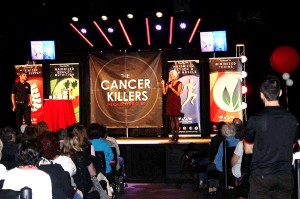I am not a big meat eater, but I do occasionally like local, grass fed, antibiotic and hormone free meats. Some die-hard vegetarians and vegans cringe when I advocate the use of clean meat on a breast cancer healing diet; I sometimes receive scathing emails after I blog about meat consumption.
I have worked with over 14,000 patients for over 34 years and I can say from experience that there is no cookie cutter diet that is a one-size-fits-all. Blood type, body type, metabolic type, age, extent of the disease, and past history all have an effect on deciding which diet is best.
Dr. Nicholas Gonzales has been researching various nutritional approaches to cancer since 1981. As I am, he is a strong proponent of using large doses of proteolytic pancreatic enzymes because of their anti-cancer effect by stimulating the immune system.
His work is based on Dr. Frances Pottenger’s research in the 1920s as well as the nutritional research by Dr. William Kelley in the 196’s. Dr. Pottenger proposed that most diseases are a result of an imbalance of the nervous system, while Dr. Kelley proposed that your metabolic type would determine your ability to heal and function at optimal health.
Dr. Gonzales divides his patients into 2 main categories according to the imbalances in their nervous system – the sympathetic nervous system and the parasympathetic nervous system. The sympathetic nervous system can be compared to the accelerator on a car, while the parasympathetic is the brake. They have to be in balance in order for the immune system and organs to function at optimal levels.
People with a strong sympathetic nervous system tend to live their lives like they have the pedal to the metal, always pushing and doing. These people typically develop solid tumors of the breast, pancreas, lung, or prostate. These people tend to do best on plant based diets with a minimal to no animal protein.
Parasympathetic people, on the other hand, tend to be slower movers and develop blood-based cancers such as leukemia, lymphoma and multiple myelomas. These people tend to do better on a meat-based diet.
Back to the point of “To Meat or Not to Meat….”
I would venture to say that all of the studies done to prove the negative effects of eating meat have been performed with commercially processed, corn fed, antibiotic- and hormone-injected meats. No wonder they come out toxic!
If you do choose to eat meat, follow these guidelines:
2) No hormones
3) No antibiotics
4) 100% grass fed
5) Plenty of sunshine and exercise
6) Humanely treated
7) Cooked slowly and at lower temperatures.
8) NEVER eat commercially processed meats such as hot dogs, bacon and sausage
Cooking is the key to making meat carcinogenic or beneficial
When meats are cooked quickly and at high temperatures, such as frying, broiling and cooking over an open flame, a potent cancer causing chemical called HCA (hetero-cyclic-amine) is produced. Exposure to HCAs causes cancer in animals. In fact, there is a direct relationship to HCAs and the development of Breast and Colon Cancer. According to a 24 year Finnish study, fried meat definitely increased the risk for female cancers.
Researchers have determined that the faster the meat is cooked and the higher the temperature, the more likely it becomes carcinogenic.
How does one reduce the formation of HCA?
1) Avoid direct exposure to an open flame. (We use a far infra-red grill that circulates the heat with no direct exposure to the flame)
2) Continuously turn the meat over frequently reduces the production of HCAs.
3) NEVER eat the charred portions of the meat since they have higher levels of the HCAs.
4) The use of marinades made with garlic, ginger and lemon juice lower the production of HCAs.
5) When cooking ground meat, adding small pieces of fruit such as dried plums, cherries and apples, lowers HCA production by up to 90%
6) Adding garlic to ground meat lowers HCA production by 60%













